Mathematics

Mathematics is a field of study that deals with numbers, quantities, structures, patterns, and their relationships. It encompasses various branches and subfields that explore different aspects of mathematical concepts and applications. Here's some information about Mathematics: P ure Mathematics : Pure Mathematics focuses on the study of abstract mathematical concepts and structures, often with no direct application to the real world. It includes areas such as algebra, calculus, geometry, number theory, and logic. A pplied Mathematics : Applied Mathematics utilizes mathematical techniques and principles to solve real-world problems and address practical applications in other disciplines. It involves areas such as mathematical modeling, optimization, statistics, computational mathematics, and mathematical physics. Algebra : Algebra deals with the study of mathematical symbols and the rules for manipulating these symbols to solve equations and understand mathematical structures. It i...






